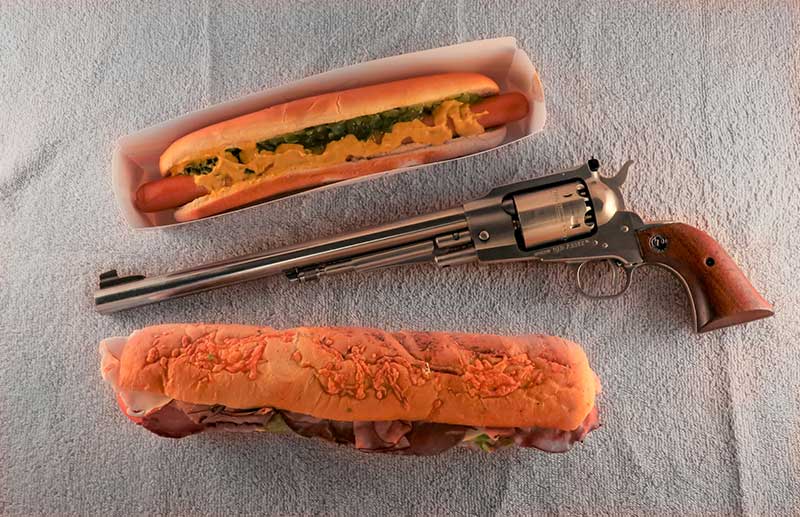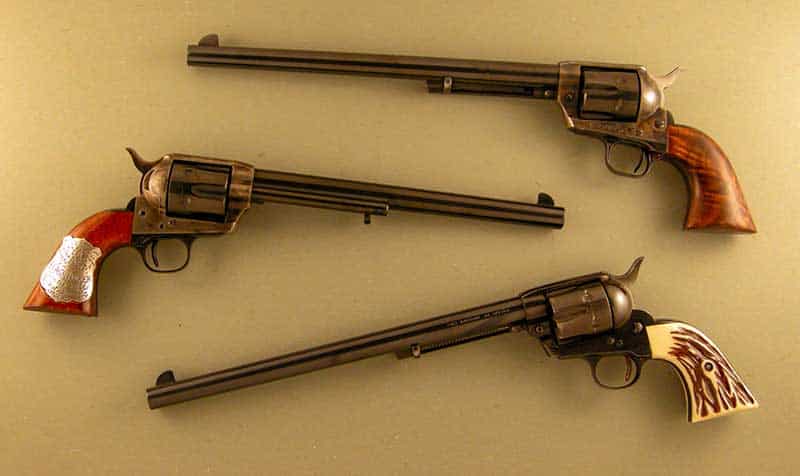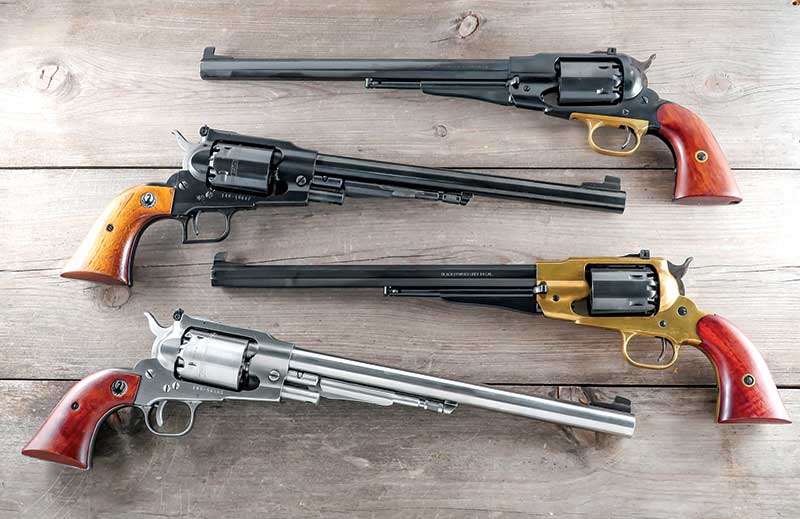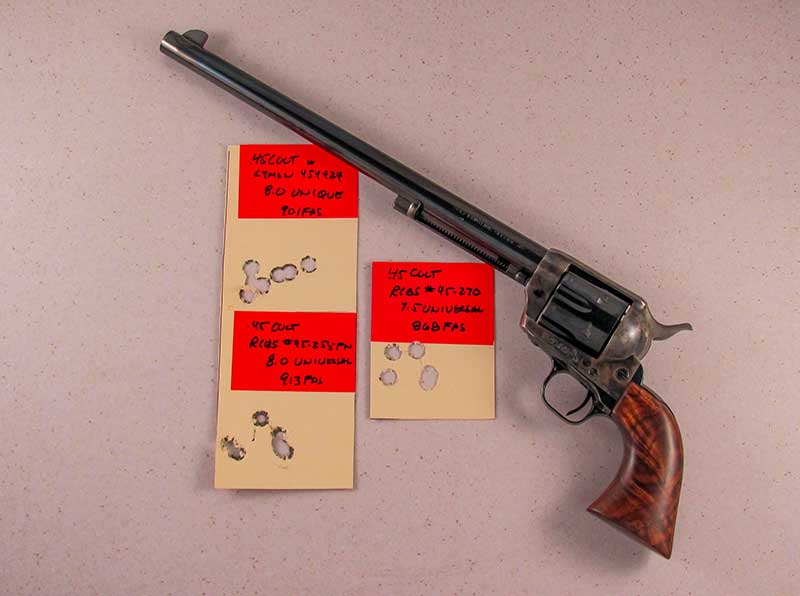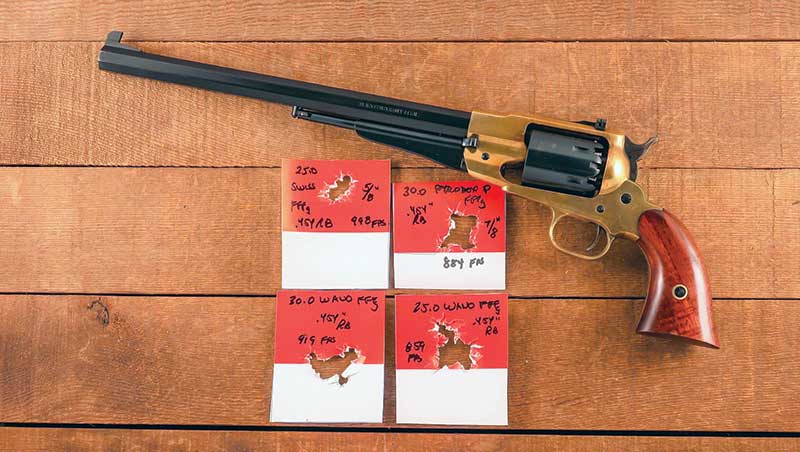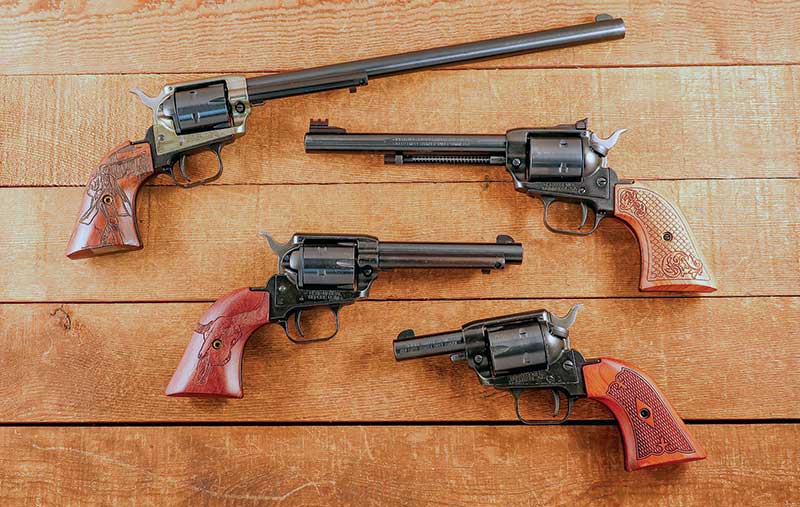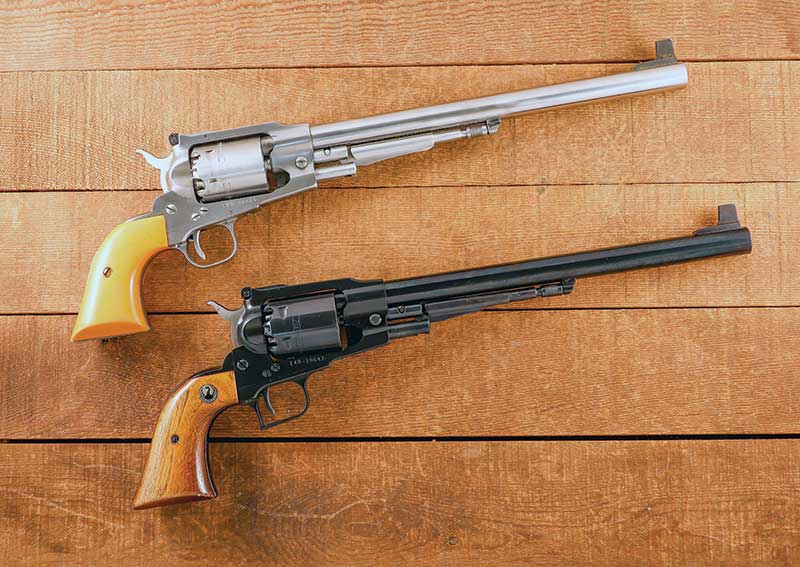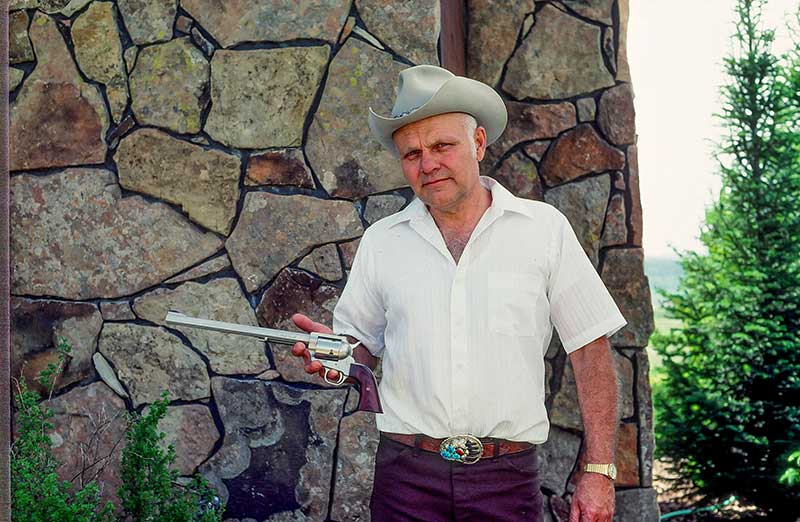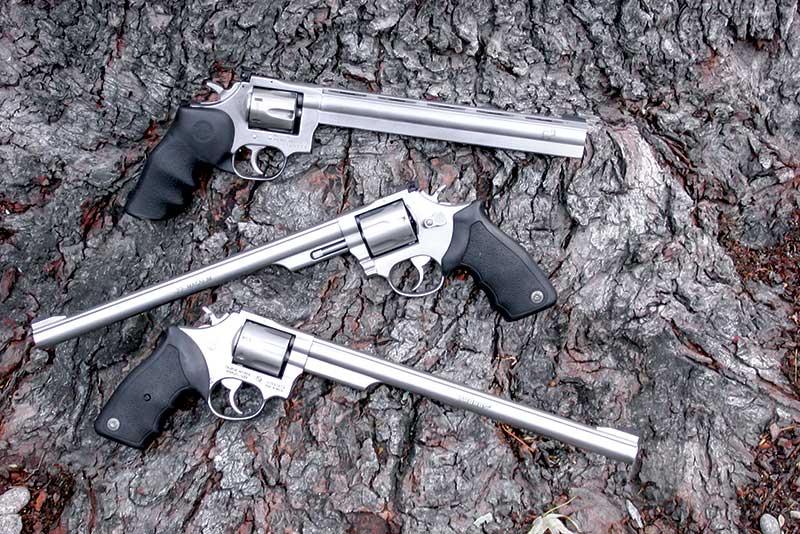I was not born with a sixgun in my hand as some might imagine, but rather, my early shooting days were confined to single barrel shotguns, .22 rifles and .22 pistols on my uncle’s farm in Ohio during the late 1940s.
In those days, in the mid- and late 1950s, firearms were easily accessible, and in Ohio, one only needed to be 16 to purchase on one’s own, and there were no federal forms. Colt Single Actions from what we now refer to as the First-Generation Run were readily available in both original and customized persuasions. My third firearm was a .38-40 Colt Single Action Army.
Enter Buntline
Edward Zane Carroll Judson was an author of dime novels in the last quarter of the 19th century whose pen name was Ned Buntline. He specialized more in fiction than fact and created long-standing myths about Western heroes. To this day, we do not know if it is legend or fact. However, he claimed to have presented five “Buntline Specials” to five lawmen in Dodge City in the late 1870s. Those men were Charlie Bassett, Neal Brown, Bat Masterson, Bill Tilghman and Wyatt Earp.
Researchers have found long-barreled Colt Single Actions, which the factory did not refer to as Buntline Specials, in a serial number range from 1876 to 1884. To date, they have uncovered less than two dozen chambered in .45 Colt, two in .44-40 and one in .44 Colt. Usually, these long-barreled sixguns were fitted with a wire stock and a long-range rear sight, which lifted out of its mortise on the top strap.
2nd & 3rd Gen. Explosion
While very few 1st Generation authentic Buntline Specials have been found, this is not quite the case in the 2nd Generation run of Colts from 1955 to 1975. Nearly 4,000 long-barreled .45 Colt sixguns marked Buntline Specials were produced. During the 3rd Generation run, Colt expanded the line of Buntline Specials producing them in not only .45 Colt but .44-40 and .44 Special as well as some New Frontier Buntline Specials. At the same time, Great Western also offered Buntline Specials with 12 ½” barrels. However, they are much harder to find, so I’ve made my own. Arizona single action sixgunsmith Jim Martin gave me a Colt .44 Special Buntline barrel which he re-threaded to the 2nd Generation pattern, and it is now installed on a Great Western. Shoots great!
Reality Or Myth?
Were these claimed five original Buntline Specials presented to five peace officers reality or myth? There are no factory records to confirm the shipping of five long-barreled revolvers to Judson. However, factory records are only sometimes complete. And while they cannot be confirmed, it can also not be proved they never existed. Most of us know of the Buntline Special from the 1950s–1960s TV series The Life and Legend of Wyatt Earp, starring Hugh O’Brian in the title role. This TV Wyatt carried a Buntline Special, first in a homemade holster and later in a custom Arvo Ojala Hollywood Holster. The real Wyatt Earp told his biographer, Stuart Lake, in the early 1930s he really did have a Buntline Special, and it didn’t slow down his draw in the least. I’ll let the reader decide if this is real or imagined! Now the TV Wyatt Earp had a metal-lined holster with a long drop loop, making it much easier to draw a 12″ sixgun than from the high-riding Mexican Loop holster Wyatt Earp would have been using in the 1880s.
John’s Buntline History
When I was a teenager back in the 1950s, I had a built-up Buntline Special, which was a 1st Generation Colt put together with a .38 Special cylinder and a 12″ barrel. I spent a lot of time doing fast draw with that gun and found I could do fairly well by dropping my left knee significantly as I drew to be able to clear leather. After practicing with this gun, it seemed like my 7 ½” .45 literally jumped out of the holster. That .38 really had no practical value then, but I certainly wish I still had it today. I would enjoy shooting low recoil .38 Specials using this relatively heavy sixgun, and it would also make a superb Single Action .38/44 Heavy Duty. Alas, the emphasis is on “teenager,” and my brains were still somewhat mushy, so I let it get away.
In the first half of the 1960s, I worked six nights a week in a tire factory and attended college five days a week. We had our three kids during this same time and the oldest one will always be linked to the Buntline Special. On a Tuesday night, I received a message at work to “Come home, take a shower, sit down and watch Wyatt Earp and I will be ready to go to the hospital.” Wyatt had just drawn his Buntline Special when Diamond Dot said, “It is time to go to the hospital.” So, my oldest daughter was born right after the Buntline Special appeared on our 10″ TV screen.
Percussion “Buntlines”
My experience with percussion sixguns goes back to my teenage years when I had an original Colt 1860 Army .44, a British Deane & Adams Double-Action .44 and a very early replica of the Remington New Model Army. Over the decades, I have continued to add replicas of virtually all the Colt and Remington conversions.
Over the years, I mostly stuck with traditional percussion sixguns; I ignored things like the Pietta Remington New Model Army Bison with a 12″ barrel. Since the cap and ball revolvers were so hard to find during the COVID situation, I put my name on several lists to get individual models when they did become available.
Pietta has cataloged their Bison .44 in three versions: blued steel, brass-framed, and stainless steel. It only took a couple of months to get the first two; however, the stainless-steel version still evades me. If any reader knows of a new or like new Stainless Steel Adjustable Sighted 12″ Pietta Remington .44, I would like to be informed. These long-barreled Remingtons are equipped with excellent adjustable sights with a square notch rear mated up with a square post front.
After acquiring my Remington “Buntlines,” I took a good look at my collection of Ruger Old Army percussion sixguns. The Ruger is not a replica but a modern cap and ball revolver using the Ruger Three-Screw action and also fitted with excellent adjustable sights. When Ruger stopped production in the first decade of this century, excellent examples could be found in the $350–$400 range. Those are long gone, and today an excellent example will run close to $1,000.
Since I enjoyed my long-barreled Remington so much, I thought to myself as I looked at the Ruger Old Army, “Why not?” I contacted my friend Arizona custom gunsmith Gary Reeder, who supplied me with a stainless steel barrel blank. I turned over both the Ruger and the barrel blank to Milt Morrison. He turned the blank down to the proper diameter and trimmed it to 12″ and I now had a Ruger old Army Buntline. I also asked Milt to see if he could find a blued barrel blank (he did) and the second Ruger (this time a blued version) soon had a 12″ barrel. We kept the adjustable Ruger rear sights as is and mated them up with Fermin Garza post front sights, giving me the same sight picture as found on the Remingtons. This quartet of percussion Buntlines are excellent shooters that are easy to shoot and exceptionally accurate.
Other Variants
When it comes to DA Buntline Specials, the field is limited. I know of no company that catalogs such long-barreled double-action sixguns. At one time, Dan Wesson offered 12″ sixguns; however, my Dan Wesson is only close as it is chambered in .22 LR with a heavy under-lugged 10″ barrel. Also, it is not exactly a DA, as it was set up at the factory for SA use for long-range competition and target shooting. At one time, Taurus offered 12″ sixguns set up with a standard weight barrel and offered in two versions, .22 LR and .22 Rimfire Magnum. I was fortunate enough to acquire one of each way back then, and they are excellent, especially for small game and varmint hunting.
A relatively new player is Heritage Manufacturing, with a varied list of SA .22s offered with barrel lengths from 3″ to 16″. There is nothing fancy about these; however, they are working guns that can sometimes be found on special sale for less than $100. They also can be had with an auxiliary cylinder in .22 Magnum for about $30 more. As with all .22 sixguns, these sixguns should be tested with more than one type of .22 ammunition. I did get misfires with one brand that apparently had a rim at the thin end of the specs and probably matched up with a cylinder cut at the large end of the spec chart. I have found Aquila .22 LR ammunition to work exceptionally well in these .22 Buntlines.
My favorite sandwich shop is Subway for several reasons. They are close by, reasonably priced and offer a menu for healthy eating. There was a time when a foot-long Subway sandwich was served as a meal. Now at this time in my life, it provides two meals. I’m also quite partial to Sonic foot-long hotdogs smothered in relish and mustard; they still slide down easily, providing one meal. The sandwiches give me much foot-long eating enjoyment; however, they are second to the pleasure I receive from foot-long sixguns.
